MATTERS OF OBSESSION
The Magic Bird, a noble ostrich of the Karoo
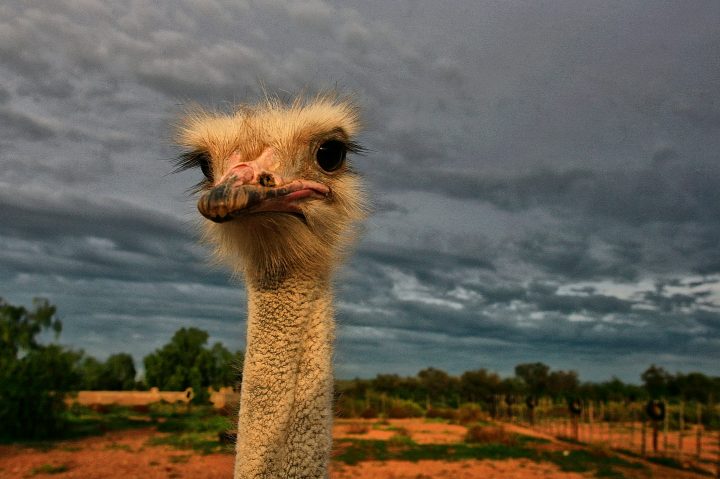
The Karoo ostrich might have had its updrafts and hard landings, but its legends still fly high.
First published in Karoo Space. All photographs by Chris Marais.
If you ever found yourself on the party streets of New Orleans on Mardi Gras Day, you might be lucky enough to spot a Big Chief Indian in full glorious spate.
This wondrous apparition, clad from head to toe in sequins, beads, rhinestones, velvet and constantly-wavy ostrich plumes, would be accompanied by his Spyboy, his Flagboy, a whole bunch of drummers, a street-walking jazz band and a few hundred dancing followers.
Down south in Rio de Janeiro, the annual Carnival would also be in progress, with thousands of lovely Samba Girls of the Copacabana dressed in a couple of sequins and very little else besides their beloved ostrich feathers.
Showgirls and their feathers
Across the sea in Belgium, the little coal-mining town of Binche has its traditional Gilles characters parading on Shrove Tuesday. During what some call “the world’s weirdest Mardi Gras”, the Gille is restricted to wearing his elaborate costume, wooden clogs and fancy ostrich feather headdress within the confines of Binche – and only on this day.
On most nights not too far from here, you might be in the Moulin Rouge Theatre in the Montmartre district of Paris, completely bedazzled by a large troupe of leggy performers, tantalising the audience behind their brightly dyed ostrich feather arrangements.
Their trans-Atlantic match is the legendary Las Vegas Showgirl, motionless (legally, she had to stand really still to appear before you in her birthday suit), bedecked all about in ostrich plumes and jewels.
But all that marvellous carnival glitz and glamour, all those high-priced gin joints and chorus-line saloons cannot match the true Romance Dance of the Plume down here in the Karoo when a male ostrich with blood-red shins begins to court his darling-to-be.
The ostrich romance dance
Monsieur will drop to the ground, spread his gorgeous wings before Madame and, with his head flung back, he will begin to thrum and gyrate, making a loud booming noise. Then, lifting himself on the tips of his toes like Baryshnikov, he will puff up all his feathers and run daintily around the eyelash-batting object of his affections.
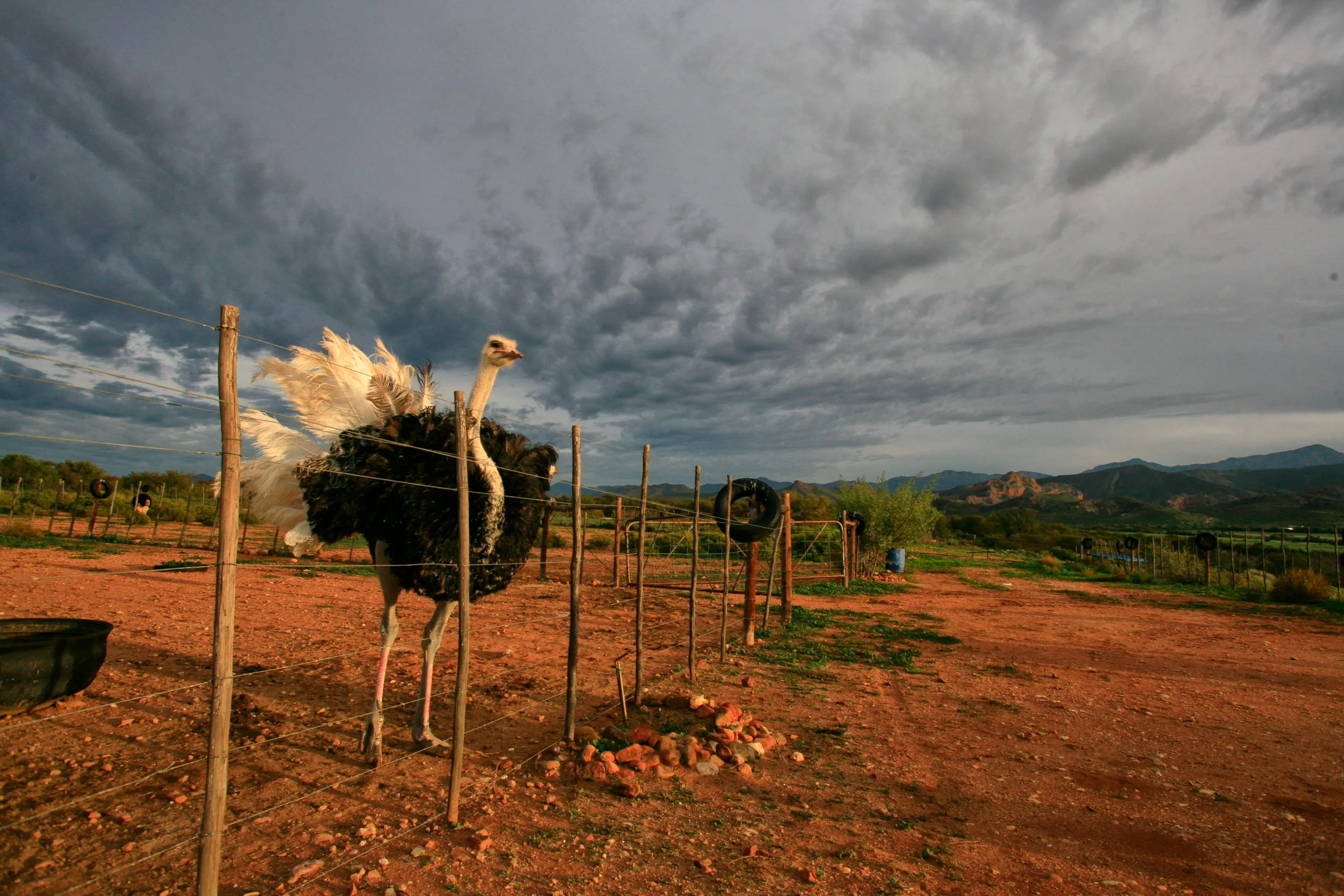
Handsome male ostrich patrolling the fenceline at Rietfontein Farm outside Oudtshoorn.
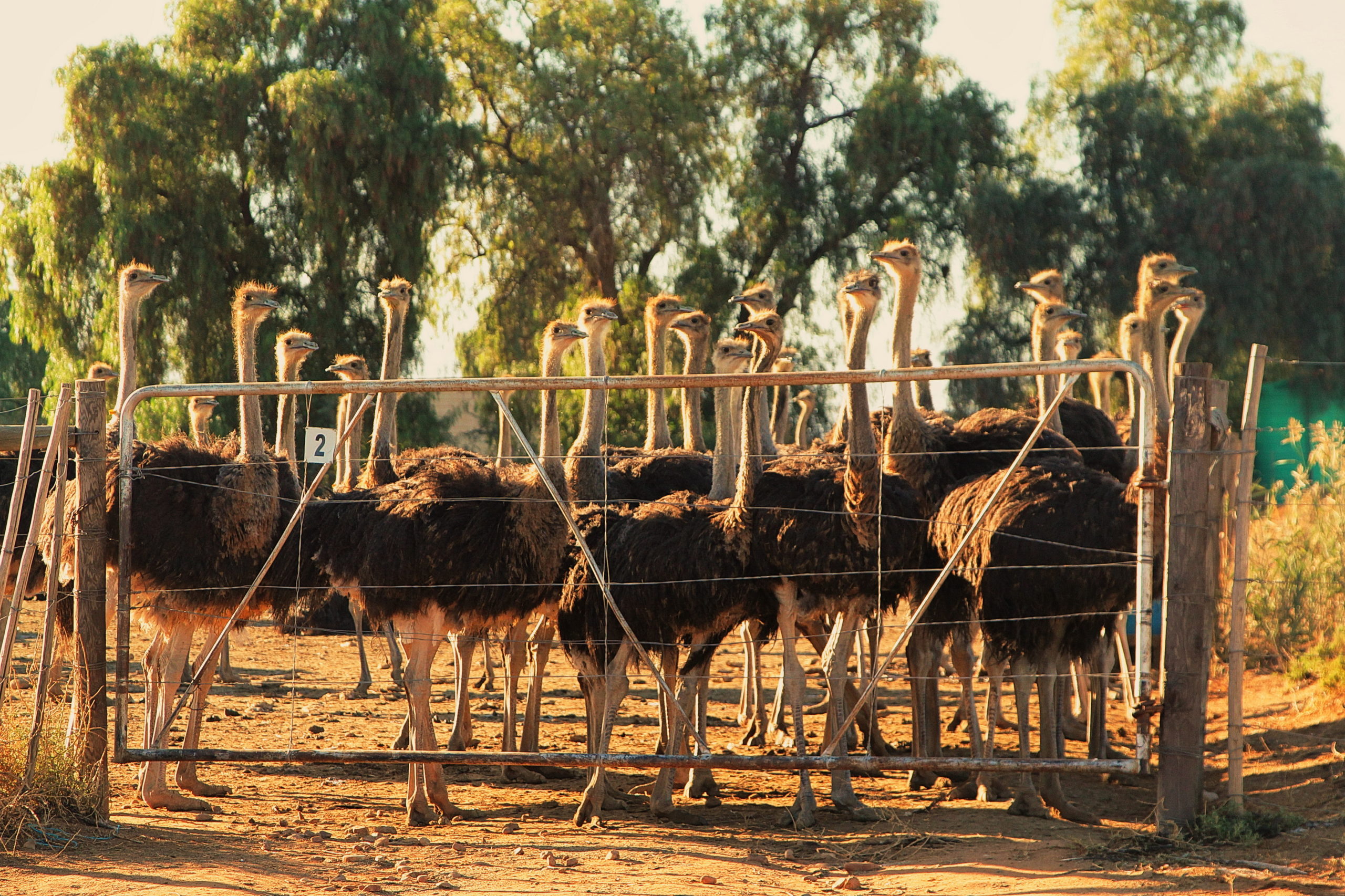
There are few birds as curious as a ‘wobble’ of young ostriches at the gate.
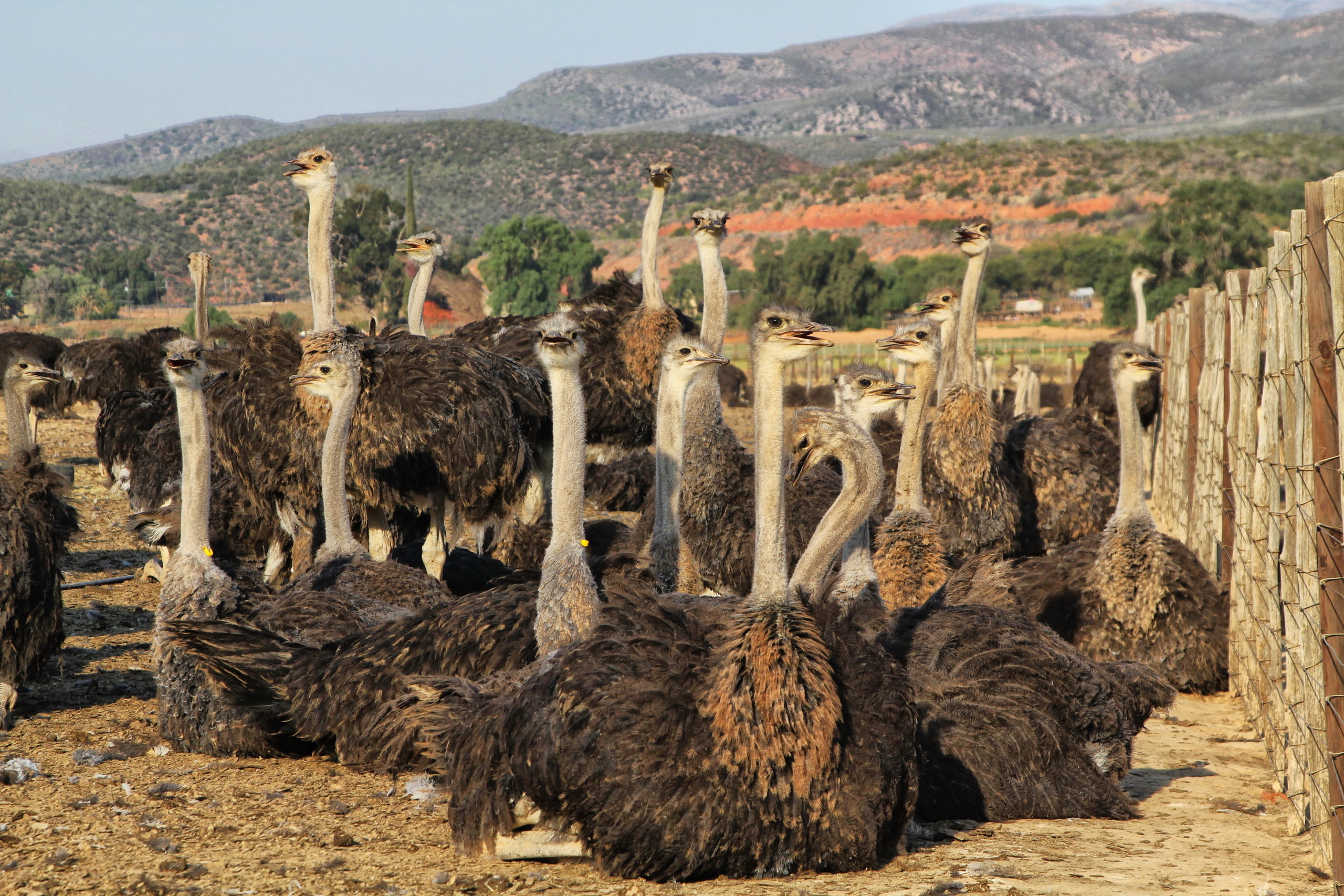
Ostriches – both male and female – generally make for great parents who share the baby-sitting duties.
If she likes the guy, Madame will modestly lower her head as she walks, shivering her grey wing feathers in approval. She will find a spot, sit down and let the games begin.
Such is the enduring inter-continental romantic lure of the ostrich, its delightful courtship moves and the gorgeous flightless feathers that line its wings.
Rietfontein Ostrich Palace
Now should you ever need a handy time portal while road-tripping along Route 62 in the Little Karoo, here’s how you get there.
Driving from Cape Town, you head through Calitzdorp on the Oudtshoorn road and continue eastwards for about 18km. Approaching the Karoo Boom farm stall on your right, look sharp left at the Red Stone Hills.
At the base of those stark crimson outcrops streaked with green algae, framed by tall blue gums and old date trees, is a palace fit for a Victorian-era royal in exile. The domed cupola gives it away.
Instantly, the mind’s eye wanders to an age of cavalry officers in uniform, ladies in big bonnet dresses, horse-drawn carriages in the driveway and kick-ass parties in the ballroom. With scandal and intrigue sure to follow.
Welcome to Rietfontein Ostrich Palace, the legendary home of the Potgieter family. Now let’s dart through that portal to a day in 1845 and a small clump of wagons outspanned about 200km west of here.
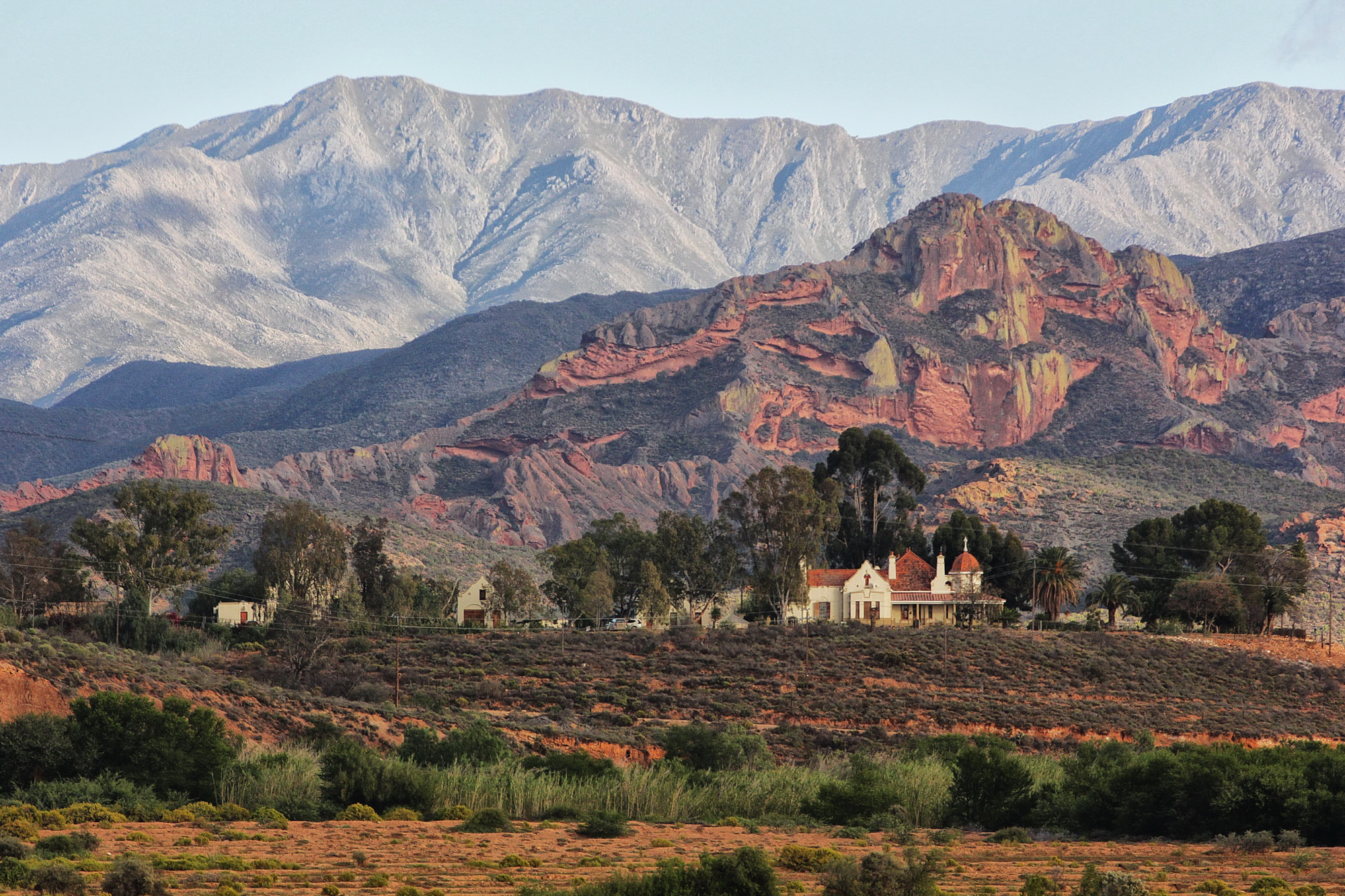
The stately Rietfontein Ostrich Palace in the distance, framed by the timeless Red Stone Hills at the base of the Swartberg range of mountains.

Rietfontein Ostrich Palace in the pink light of a Karoo dawn.
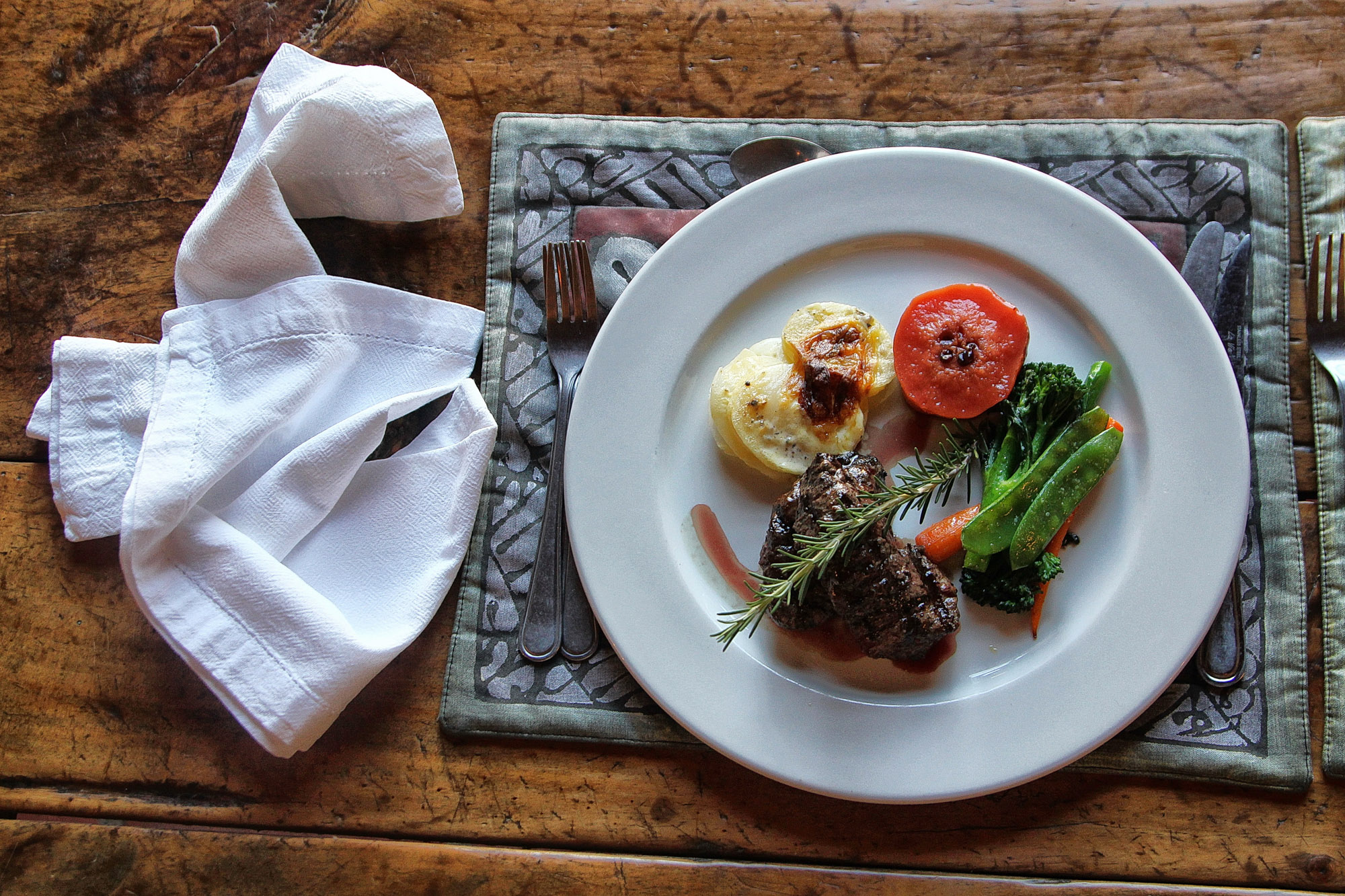
Dinner at the Rietfontein Ostrich Palace – ostrich fillet on the menu.
The pioneering Potgieters
Young Armaans Potgieter is a wagon driver who goes hunting for the pot in his down-time. He returns with an antelope of sorts and a couple of wild ostriches bagged along the way.
Armaans saves the tail and wing feathers of the birds and hopes he might flog them to a passing hide trader (smous) for a couple of pennies. Instead, gold coins fall into his hand along with some equally valuable advice from the smous:
“Buy land and farm with ostriches.”
And that’s how Armaans Potgieter becomes one of the world pioneers of ostrich farming, raising these glorious birds which had been hunted and killed (the lucky ones were simply stripped and sent off naked) for thousands of years before this.
Millennia ago, when Egypt was a major power, one of its many deities was the goddess Ma’at. This rather fetching young beauty was all about order, truth, justice and harmony. Her headdress contained a single white ostrich feather, and when you died your heart was weighed against that plume in the Afterworld. If you had lived a decent life, your ticker was lighter than the Feather of Truth and your chances of gaining entry to Paradise were fair. If not, well…
An ancient obsession
The Romans appeared to be a little more irreverent about the ostrich. Heliogabalus, who definitely would have failed the Egyptian Feather Test, was arguably the worst-behaved Roman teenage emperor of them all – quite a feat back then.
Heliogabalus fancied a three-day orgy with a very colourful menu. He once ordered 600 ostriches to be decapitated so he could serve their brains to his guests as teaspoon-sized appetisers. However, you do have to see this act of culinary insanity in its context: on occasion, the teenage potentate also ordered up platters of flamingo brains, parrot heads and peacock tongues. And you don’t want to know what these overfed gentryfolk did between courses.
He ran his empire in this macabre fashion from the age of 14 for four years until his granny, Julia Maesa, had enough of the brat and ordered the Praetorian Guard to dispose of him one night. You can read all about this royal rogue in The Fat Man’s Food & Drink Compendium by Tony Grumley-Grennan.
Biblical Noah, charged with loading his Ark full of breeding pairs of various beasts, also had to pack an astonishing variety of feed for them. Various religious texts claim that he even stashed a supply of glass for the two ostriches in the hold of his vast cargo ship before the floods arrived.
Medieval literature has it that the female ostrich possessed the ultimate “lazy eye”, and could make her eggs hatch by simply staring hard at them for a while.
Fashion and the feathers
In those crazy Victorian times, women wore all kinds of dead-bird feathers on their hats, the most popular being ostrich plumes. In fact, if you look carefully at old photographs of various potentates through history, you’ll note that the guys wore ostrich plumes on their ceremonial helmets, and the 12 black horses that pulled the Duke of Wellington’s funeral wagon in 1852 all had clumps of black ostrich feathers on their heads.
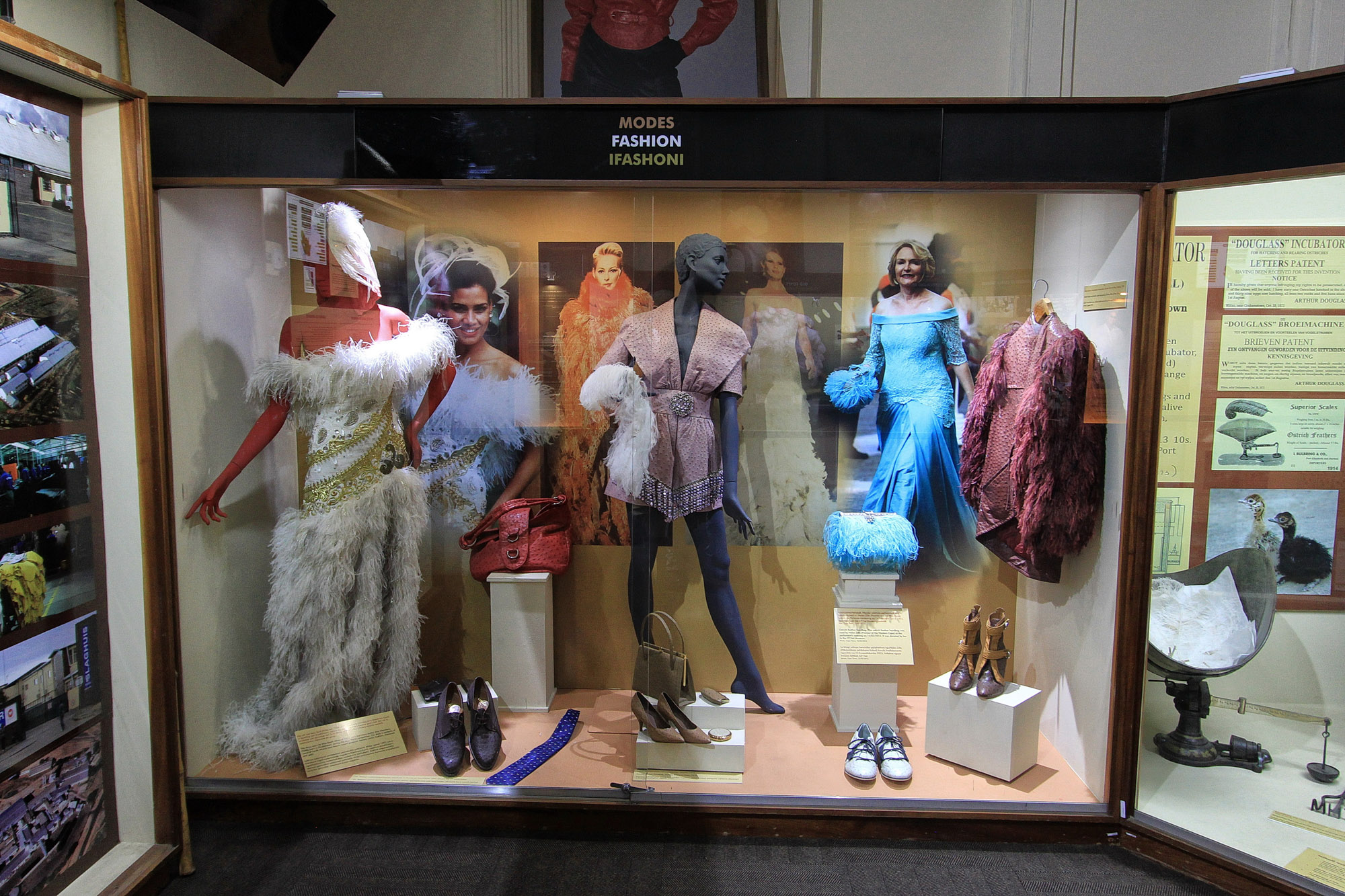
Modern fashion displays using ostrich feathers – politician Helen Zille in the line-up at the CP Nel Museum.
And, possibly inspired by the vaguely erotic dance rituals of the ostrich, the plumes thus became an essential part of a showgirl’s costume from Paris to Rio de Janeiro. Big Chiefs at the New Orleans Mardi Gras and the various Junkanoos of the Caribbean islands wore them as well.
Someone simply had to start farming these wondrous birds. You couldn’t just keep killing them off for their wing feathers.
The rise of Veldskoendorp
In the first half of the 19th century, Oudtshoorn was a hardscrabble village described by its detractors rather haughtily as Veldskoendorp – a place of poor man’s shoes. It was officially named Oudtshoorn in honour of a newly-appointed Cape governor who never made it to these shores – he perished on the sea voyage out.
The 1860s began with a killer drought and ended in the Golden Age of the Ostrich. The ostrich farming frenzy really took hold when one Arthur Douglass invented the incubator in 1869, and production was vastly increased.
Farmers had to find markets for their feathers, and so a host of Jewish Lithuanian feather merchants criss-crossed the Little Karoo as middle-men in this fledgling industry.
Oom Swepie’s story
Oom Swepie le Roux of Doornkraal Farm east of Oudtshoorn, is every bit the baronial storyteller, who comes complete with his own family feather palace and a tasty brand of sparkling muscadel-grape rose called Tickled Pink. The front label sports a running ostrich and the back-label speaks of spicy food, good company and naughty women.
Well into his 80s, Oom Swepie tells the story of his Oupa Gert, his Ouma Maggie and the various smouse who visited Doornkraal.

Oom Swepie le Roux comes from a long line of Little Karoo ostrich farmers.
“They came for the feathers, the fare and the brandy cellar,” he says. “They would arrive from their dusty journeys, and Ouma would make them bathe first. She was also a devout Christian whose life’s ambition was to convert at least one Jewish pedlar, so she’d make them attend a service before dinner.
“After supper, Oupa and the smous would go down to the brandy cellar, light the lamps, share a drink and discuss the feathers, laid out for inspection. Then the haggling would begin.”
Oupa Gert may have prospered from his lamplight negotiations but Ouma Maggie, they say, had no luck converting the smouse.
There are ostrich palaces scattered about the Eastern Cape, but they really do seem to have a nest in the Calitzdorp-Oudtshoorn-De Rust district of the Little Karoo.
The feather boom mansions
Back in the heyday of the ostrich industry, when a prime wing feather was worth more than its weight in gold, the new dry land millionaires wanted to tell the world of their riches. The Feather Boom Nouveaux Riche set had massive mansions built of local sandstone, sparing no expense on architectural shout-outs like turrets and parapets that served no practical purpose. Suddenly families had to have ballrooms, homes with 20 bedrooms and coach houses, all built in an eccentric froth of styles that drew from the Edwardian, Tudor, Elizabethan and Victorian eras.
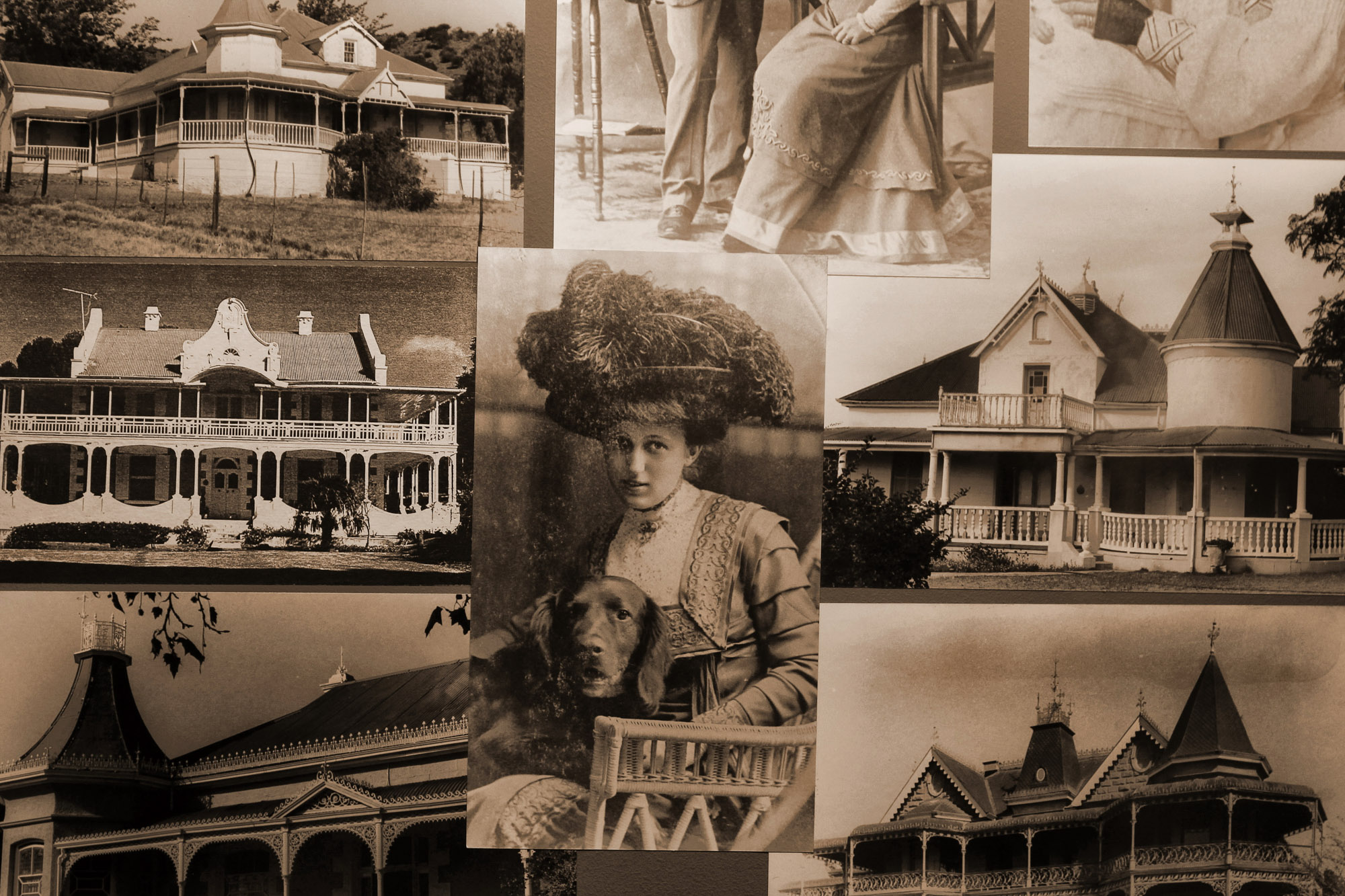
The days of feathers, mansions and fine things on display at Oudtshoorn’s CP Nel Museum.
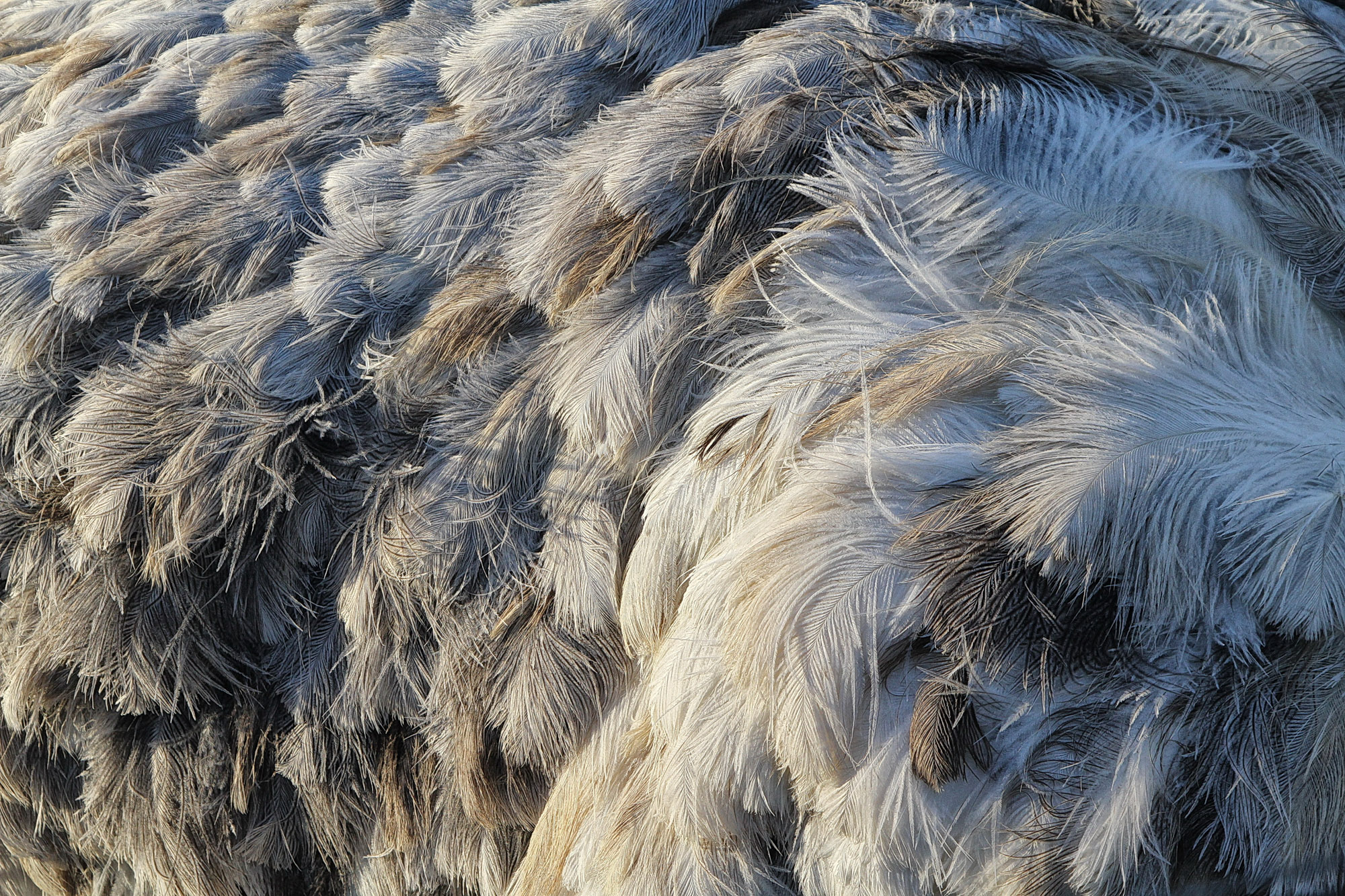
Ostrich feathers – at one time worth a fortune.
The two architects who made serious names for themselves here were Charles Bullock and Johannes Egbertus Vixseboxse. You see their handiwork all over Oudtshoorn, in the form of mansions that have been repurposed into old age homes, museums, little businesses and, of late, guest houses.
Dining rooms for 100 guests, marble baths that held 1,500 litres of water, Italian ceramic tiles around the fireplaces, mahogany inlaid libraries, Carrara marble in the kitchen, Delft and teak fancies, broekielace (cast iron railings) and burnt bricks, endless verandahs, stained glass windows, big lion carvings and other expensive doo-dahs from all corners of the Earth – it was not the Age of Minimalism. The diamond magnates of Kimberley and the gold barons of the Witwatersrand stood back in envy.
You can only imagine how the mail order catalogue business flourished in those days, how goods-laden ships flowed endlessly back and forth between continents while ostrich barons’ bank accounts just grew fatter and fatter with every plucking.
Adventure on the Niger
This saga of the South African ostrich industry comes with its own exotic adventure story, worthy of an Indiana Jones film or an Allan Quatermain classic.
Despite all these profits, the ostrich farmed in the Little Karoo was just so-so. It simply did not possess the ultimate plume quality to match that of the Barbary Bird, found somewhere in North Africa. There was a need to enrich the South African breeding stock with the Barbary, to give the locals an edge over their rivals, the USA. The magical feather everyone was after went by the name of Evans-Lovemore. It was blunt, strong and double-fluff dense.
So a small and discrete party, led by Russell Thornton of Grootfontein Agricultural College in Middelburg, set out in September 1911 on a steamship up the Niger River in the general direction of Timbuktu.
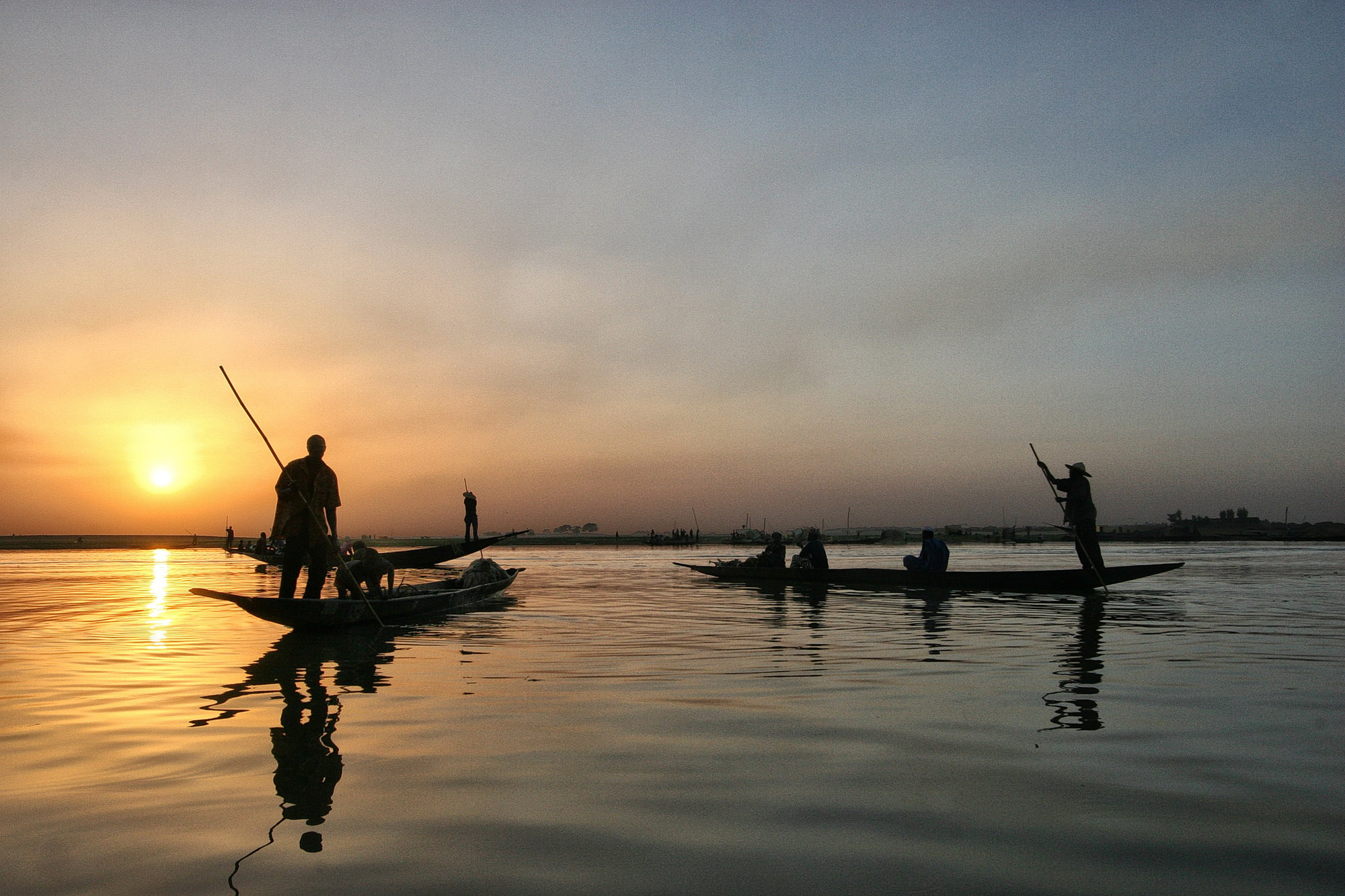
The Thornton Expedition travelled towards Timbuktu on the fabled Niger River. Photo by Chris Marais
A couple of train journeys later, they were based in Kano, northern Nigeria. They offered a reward for a sample of the Evans-Lovemore, located a likely source from Fort Zinder in French Sudan territory, recruited more than 100 porters, kept an eagle eye out for Tuareg raiders and hit the desert with gusto.
Thornton begged the French fort commander at Zinder to allow them to export some of the indigenous ostriches. The answer was a firm non, and so they returned to Nigeria and put out a general appeal for Barbaries once more.
Ostriches from all over the region were presented to the South Africans and gradually, bird by bird, they gathered a flock of Barbaries to take home. Nearly 150 specimens were carefully trucked back to the coast and shipped down to South Africa. Thornton was hailed as a local hero, the SA breeding herds were enriched and the Americans were full of envy.
The parties
In fact, so entrenched was the South African grip on the ostrich trade that, when the Titanic sank in 1912, part of its most valuable on-board cargo was a shipment of our feathers bound for New York markets, insured for millions of dollars.
The next two years of Oudtshoorn’s rather eccentric existence can be described for millennials as the old-time equivalent of the dot.com billionaire boom of Silicon Valley, California. The prime feathers from three ostriches could buy you a Model T Ford. One really perfect plume could be traded for a Union Castle berth from Cape Town to Southampton. It was The Great Gatsby before The Great Gatsby.
Bullock and Vixseboxse went into overdrive, servicing the architectural whims of the various ostrich overlords and their bigwig wives.
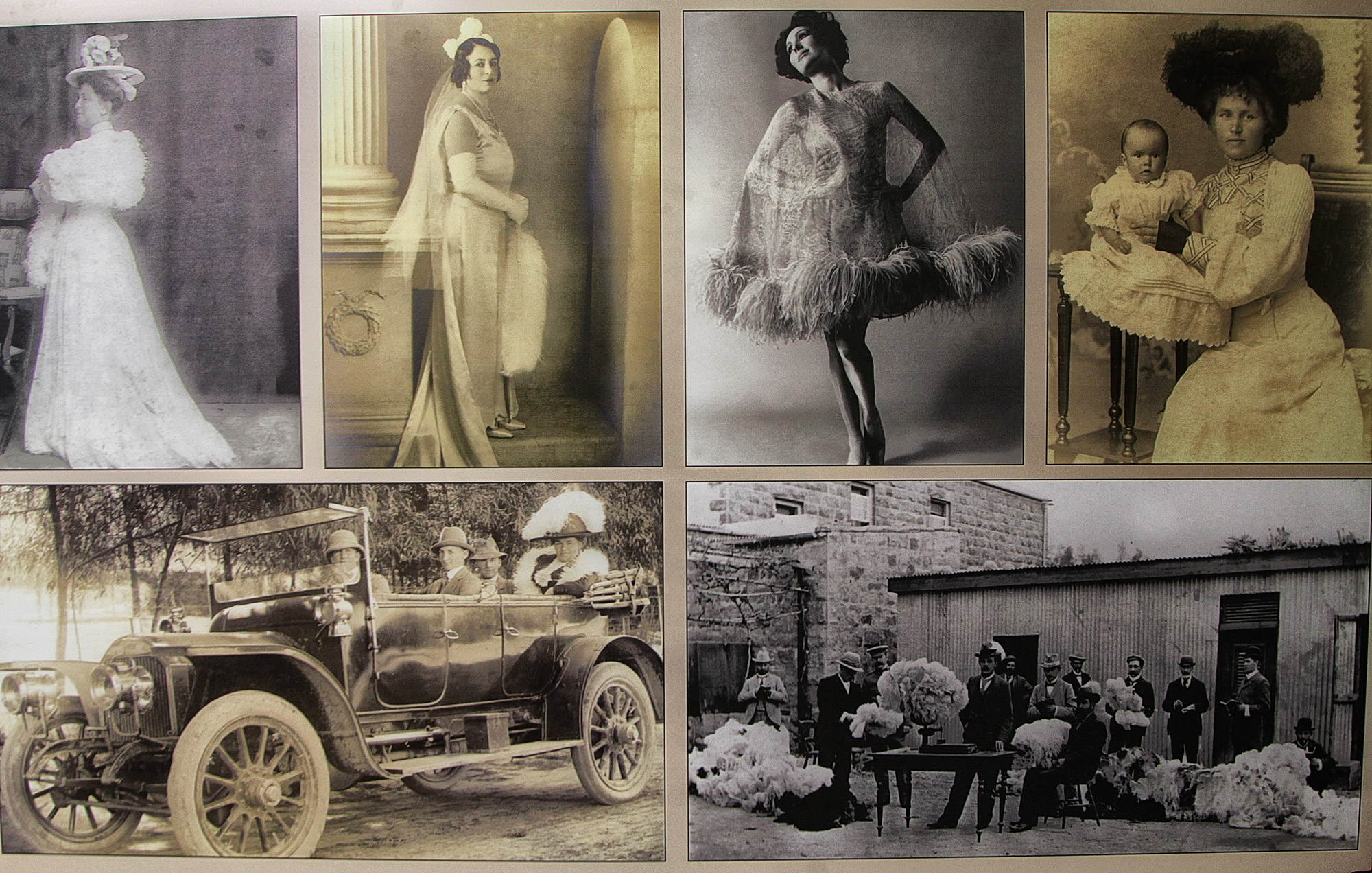
The Ostrich industry in its boom time, just before the crash of 1914.
The hangover
In 1914 it all came crashing down. World War I turned the globe away from the light-heartedness of party feathers; the open-top automobile made the wearing of big hats impractical, if not downright dangerous; it became a mark of shame to wear any body part of a bird on your head. It was the inevitable perfect storm of misfortune for this vanity-based industry and its kingpins. In so many ways, the carnival was over.
It was recorded that one feather dealer had a cheque for £100,000 honoured by his bank in early 1914 and a cheque for £1 rejected the next year. There were suicides, bankruptcies, mysterious disappearances and empty mansions on the Karoo veld.

The Karoo ostrich: gorgeous as ever, grubby beak and all.
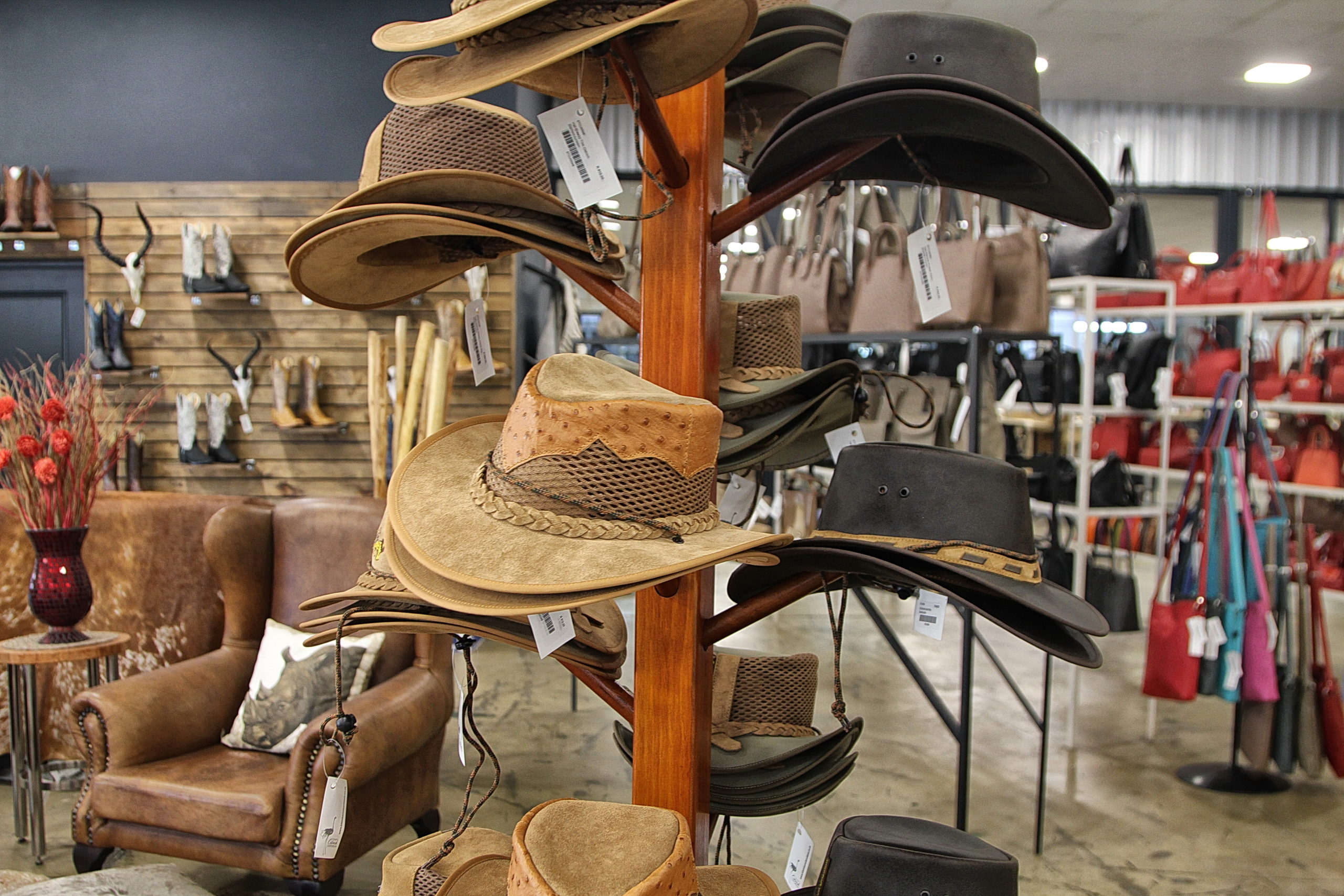
The ostrich skin cowboy hat – part of modern Western Wear.
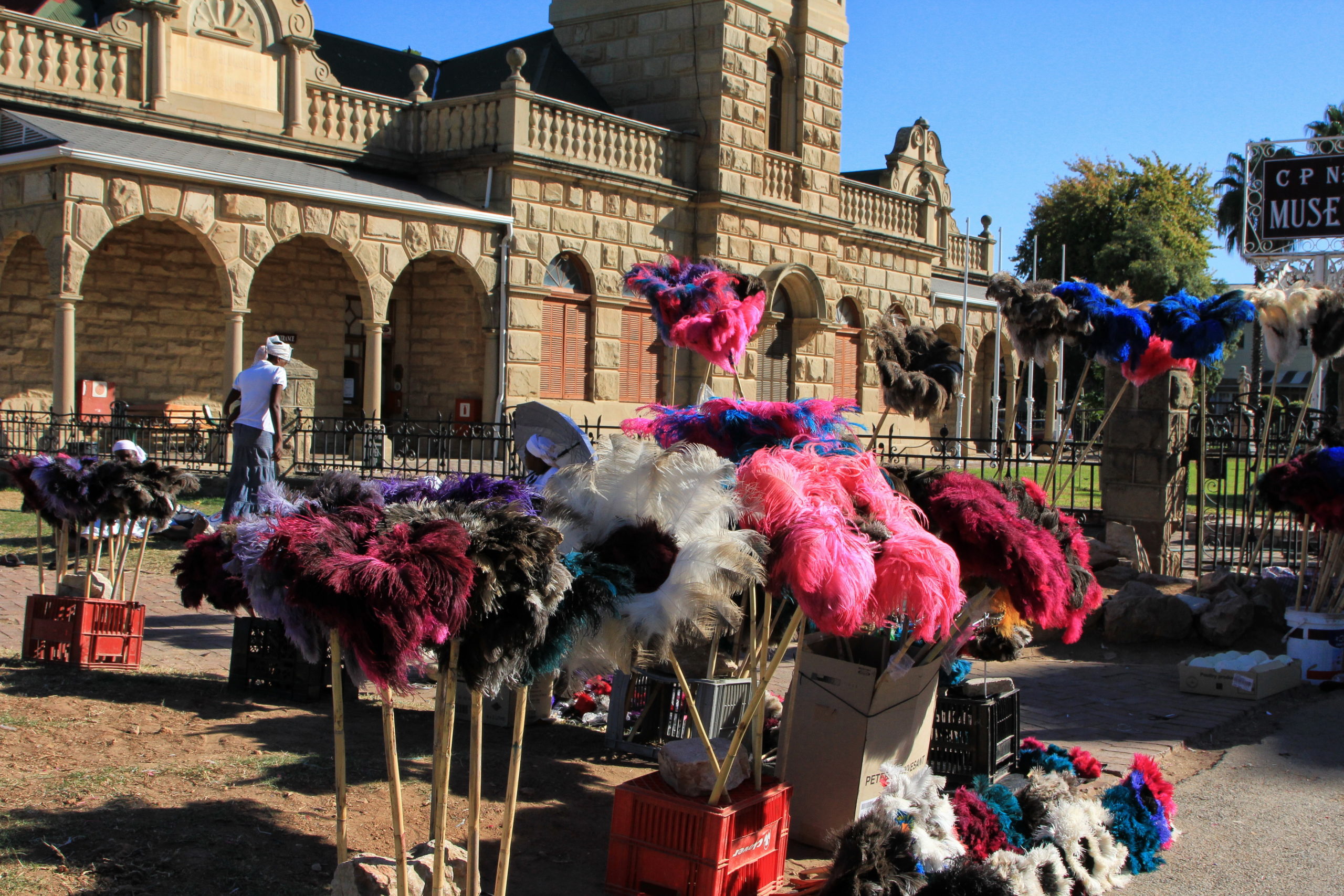
The ostrich feather duster sellers outside the CP Nel Museum in Oudtshoorn.
In the past century since the Feather Fall of 1914, the ostrich industry has had a roller coaster ride consisting of a resurgent plume market, a growing taste for ostrich meat and a wider use for ostrich leather. And do not discount the ongoing boom in feather dusters.
Bird flu scares and European Union bans have come and gone, and the present southern African drought has also added to the decimation of the formerly vast ostrich flocks of the Little Karoo.
The ostrich arises

The Oudtshoorn ostrich flocks have been diminished due to the long drought – but they will return.
Now, however, the industry shows signs of innovation. The Klein Karoo Ostrich Emporium in Oudtshoorn has an extensive workshop where crafters fashion a variety of ostrich goods. Ostrich show-farms like Safari, Highgate and Cango tell the big bird story every day to busloads of tourists from everywhere.
And the palaces are being spruced up again. At Rietfontein, where it all began, you can stay in elegant accommodations within spitting distance of the old feather mansion and be hosted by Kobus Potgieter, descendant of The Original Armaans, and his wife, Elmarie.
The Rietfontein flock has been reduced to one rather feisty male and his two wives in a paddock out back. But they do a really good job of representing their legendary species, and the memory of their many flightless ancestors. DM/ ML
The Magic Bird is a chapter in Karoo Roads – Tales from South Africa’s Heartland, by Chris Marais and Julienne du Toit (MLM Publishers, 320 pages, 201 black and white images, 1 Karoo Map). To purchase, either order from www.karoospace.co.za or email [email protected] for details.
Chris Marais is a storyteller from Karoo Space.
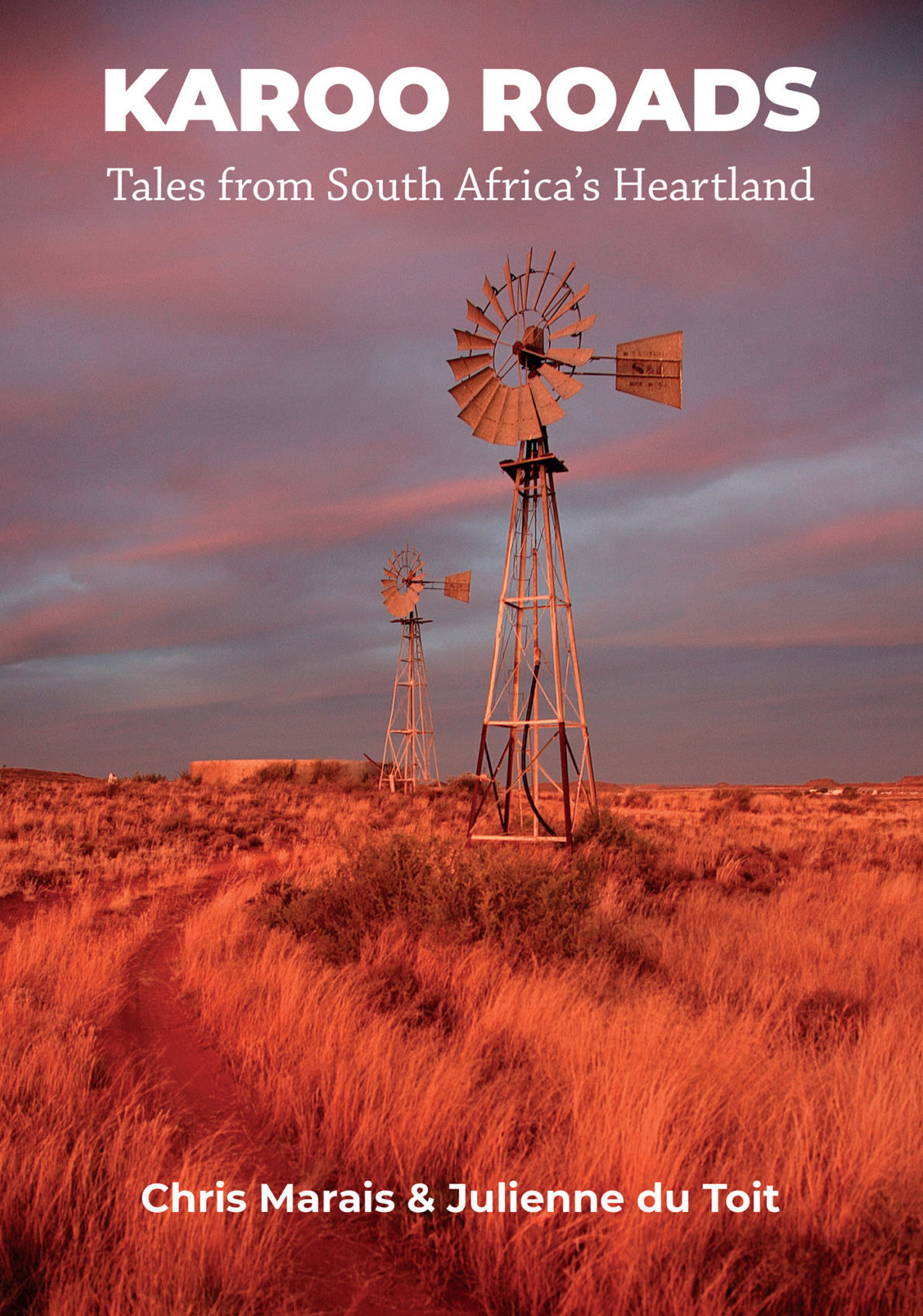
Useful Links:
- Oudtshoorn Tourism: www.oudtshoorn.co.za
- Rietfontein Ostrich Palace: www.rop.co.za
- Safari Ostrich Farm: www.safariostrich.co.za
- Highgate Ostrich Show Farm: www.highgate.co.za
- Cango Ostrich Show Farm: www.cangoostrich.co.za
- Klein Karoo Ostrich Emporium: www.capekarooshop.co.za















 Become an Insider
Become an Insider
Chris Marais always wrote beautifully — from the Rand Daily Mail days. And it’s a delight to read this. I had relatives who must have been traders in Oudtshoorn and I’m sure were never converted! There was a museum in Oudtshoorn with part of it devoted to the Jewish community there — but which curiously never made any mention anywhere in the museum, of black people. I was told that was because they “did not have a history there”. With a bit of luck that has changed.
It has changed Pat and for the better, to be much more inclusive but retaining all the old grandeur. A superb museum, well run well staffed from our experience of a visit last March.
Dreamily romantic notions, but for the sake of human folly unbearable cruelty continues to be meted out unabated on these ‘magic’, ‘noble’, ‘glorious’ and essentially wild birds. On farms the pathetic majority spend their entire, rather short and unnatural lives crammed into bleak, leafless feedlots where they endure the humiliation and pain of captivity exposed to searing daytime temperatures. Annually around solstice, numerous ostriches in the Karoo succumb to the intense heat because no shade is provided. In effect this means that most days throughout the long, hot summers these poor birds are teetering on the brink of death, until the final horror of the day they’re trucked off to the abattoir to be unceremoniously slain.
It’s not surprising that under such an assault on the natural order of things there have been several outbreaks of numerous strains of avian influenza (including H5N2 and H7N1) and it’s just a matter of time before…well we know how the story unfolds.